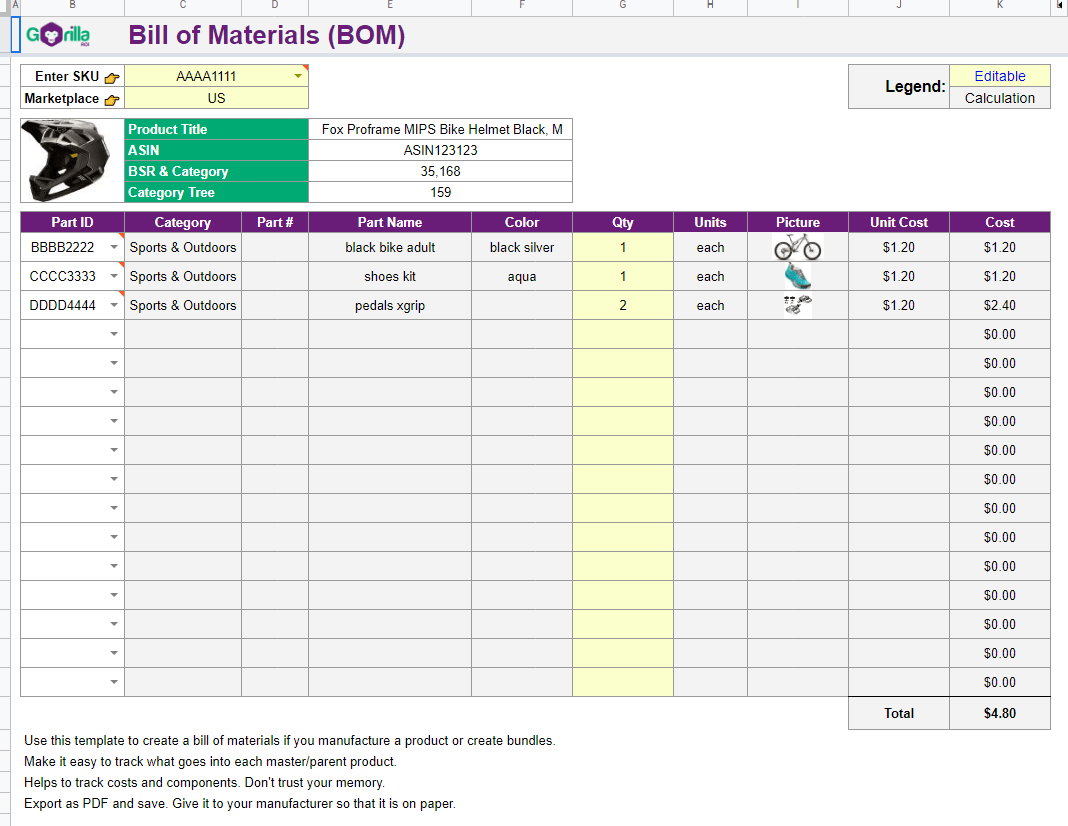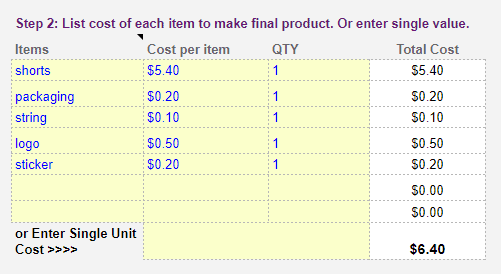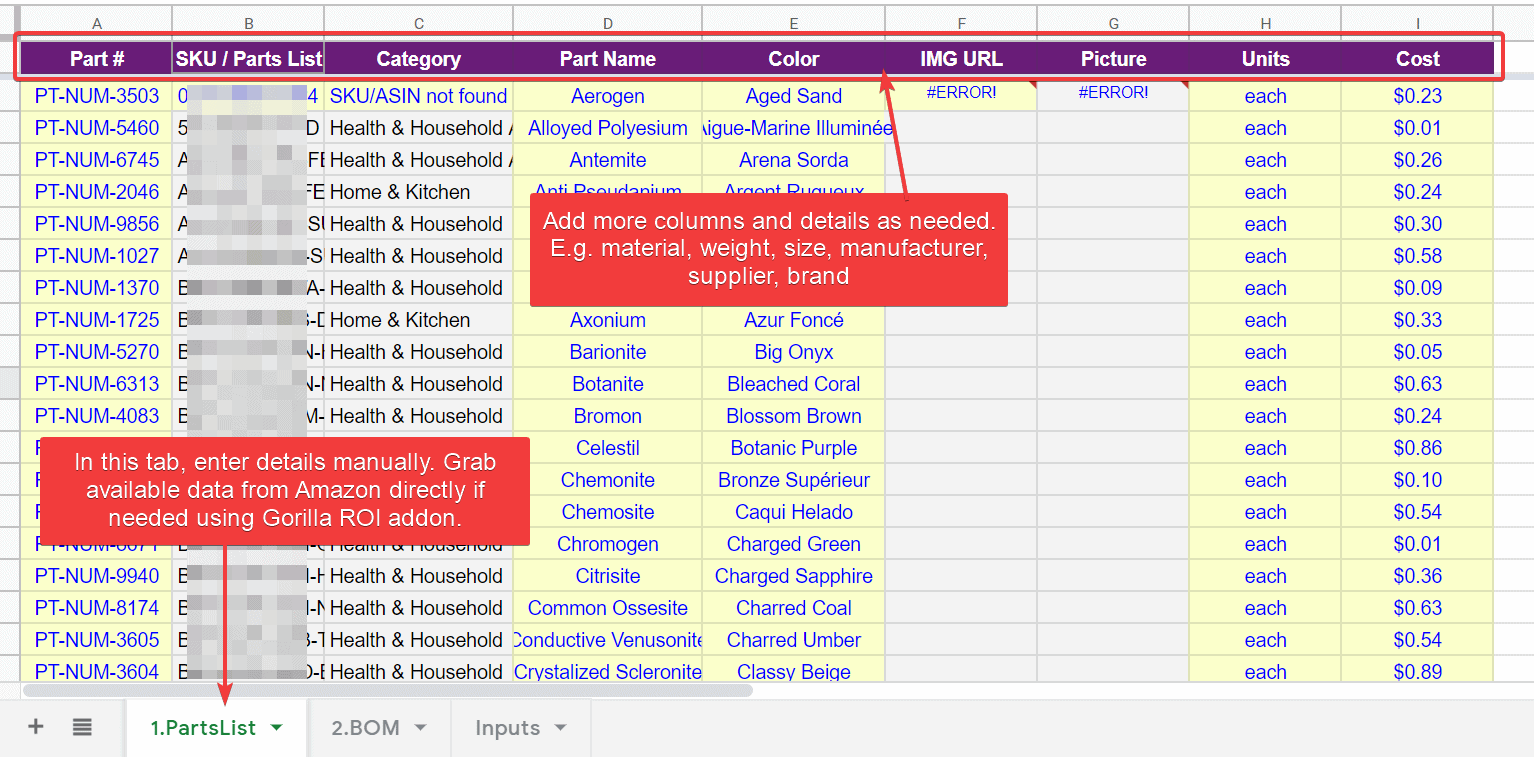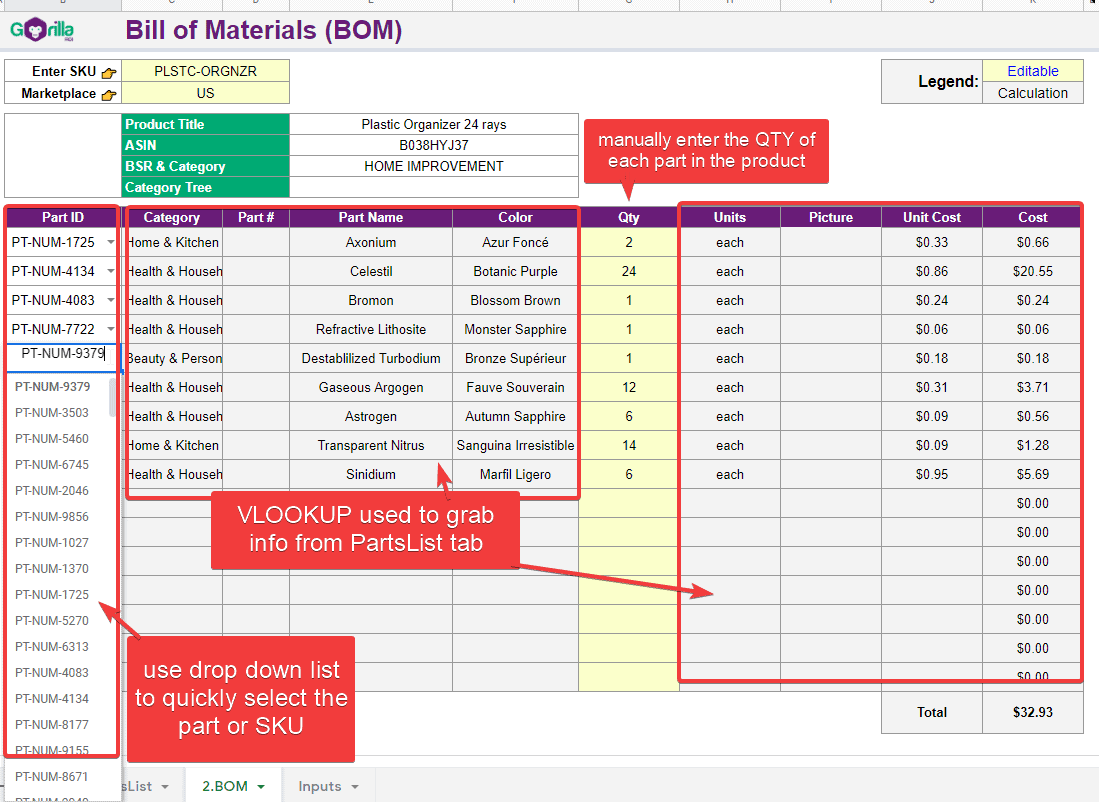What you’ll learn

What is a Bill of Materials (BOM)?
A bill of materials (BOM) is an extensive list of raw materials, components, and assemblies required to construct, manufacture or repair a product or service. – Investopedia
Think of it as a list of ingredients of a recipe to manufacture a product. Just without the instructions.
I also think of it as a checklist to manufacture a product and to record my costs.
Here’s why.
Biggest mistake of not using a Bill of Materials
If you manufacture in China, one of the biggest mistakes you can make is not using a Bill of Materials.
- You can easily get ripped off
- You end up with low quality goods
- You find quality fade with future orders
Why?
There are great factories in China. After many failed products and disasters, we finally found our perfect manufacturers. But it took a lot of effort and using a BOM helped substantially.
Tell me if I’m wrong, but typically, your process for finding and ordering with suppliers will be like this:
- Go to Alibaba and search for a product
- Contact 3-5 factories and ask for a quote of the product they listed
- Finalize down to a couple
- Get samples
- Choose a single factory
- Make a small order
- Send inspector
- Send shipment
- Receive shipment
- Get shocked with low-quality products or how you were ripped off
In China, a Bill of Materials will help to prevent this.
How a BOM will save manufacturing problems
Ok.
A BOM won’t save all your manufacturing troubles, but it eliminates miscommunications and murky expectations immediately.
By having a detailed breakdown of how the product is manufactured, you end up with a lot of leverage, transparency and you can control the product.
With a BOM:
- you know how much each component will cost
- if prices rise – you can trace it to which component is causing the price increase and determine whether it’s true or a lie
- if quality fades – you can trace it to the problem
- when comparing suppliers – you can compare apples to apples and see what materials they are using and how much they are charging
- know if you are dealing with a middle man or not. Middle men won’t be able to give you a BOM or detailed quote.
If your price quotes are very basic and look something like this from a supplier:
- yoga mat 20×30: $12
where you are only getting a single dollar value, and there is no breakdown, you are likely overpaying.
It’s convenient to get an all-in-one price, but it’s never the best. You don’t want your supplier to roll up prices into a single value.
Knowing your exact costs means that you can control the negotiations. Not be controlled.
This is a screenshot from our pricing calculator, but a BOM template is simpler.
Benefits of Using BOM Functionality
Implementing BOM functionality is invaluable for Amazon sellers, as it provides a centralized view of all product components and their costs. This clarity improves cost control by allowing you to identify specific components responsible for price increases, enabling more informed negotiations. Additionally, a detailed BOM ensures production consistency and helps mitigate quality fade—a common issue in outsourced manufacturing—by holding suppliers accountable to exact specifications. BOMs also streamline supplier comparisons, allowing sellers to assess material quality, pricing, and supplier credibility accurately. By incorporating this functionality, sellers can manage products more efficiently and scale with confidence.
Bill of Materials example – Plastic organizer
Regardless of how simple you think your product is, there are too many different materials to ignore.
Look at this plastic organizer.
When manufacturing this, you could go the easiest route and ask for the exact same thing and only change the sticker or the box design.
This is what most newbies do anyway – and then lose money and cry that it’s impossible to sell on Amazon.
But you’re the serious buyer and the supplier will ask you questions like:
- What type of plastic do you want to use? PP, ABS, AS
- Quality of the plastic
- Density of the product
- Finish of the plastic
- Color of the plastic
- Mold costs and if there are more than 1 required
- Labels that go with the organizer
- Type of packaging
- Any wrapping
- Type of cardboard, thickness, quality
- and the list goes on
Sure. Not everything is related to the BOM, but it can easily be integrated.
You may think you know it all as you go through it one by one with the manufacturer, but what about 1 year later when you have a make a change?
Or when another person in your company needs to take over the project?
Or what if you need to switch manufacturers?
A BOM means you don’t have to start from scratch and you know your exact requirements and cost.
If you were paying $0.20 for a certain GSM cardboard, and the new supplier is quoting $0.50, you can bet they are taking a cut.
You can now bring this up and ask what the difference is. You may choose to supply the cardboard to them if they keep insisting it is the best price they can offer you.
Downloads Page: Get FREE Spreadsheets and Other FREE Resources
Alternatives to BOM Spreadsheet Templates
While this BOM template offers flexibility and customization for Amazon sellers, other solutions may be more efficient for complex manufacturing or high-volume operations. Options such as dedicated BOM software or ERP (Enterprise Resource Planning) systems automate component tracking, updates, and supplier information, which can reduce manual work and improve accuracy. However, these systems are often costly and may require technical setup, making this BOM spreadsheet template a practical, accessible choice for most small to medium-scale sellers.
How to use this free BOM template
There are two main tabs.
- Parts List to host all the detailed information regarding raw materials, parts and all the nitty gritty details.
- The BOM template where you would construct the full list which you can then use for reference or save as a PDF.
1. Parts list of the BOM spreadsheet
In the tab titled “1.PartsList”, this is where you enter detailed information of each part. The more granular you get, the better in the end.
Add as many columns as needed like manufacturer, weight, size, shape, brand, supplier, and more.
The spreadsheet is unlocked and you can customize it 100%.
Most of the data will have to be entered manually. You probably already have a list that you maintain somewhere else. You can copy it into this sheet.
You can mix and match data from Amazon if you wish. If there is a specific data point like brand or dimension that you want to pull, use the matching Gorilla function to get this information.
E.g. you can get product info like titles, weight, dimensions using GORILLA_PRODUCT(), category using GORILLA_CATEGORY(), and also the pricing of the final product using GORILLA_MYPRICE().
A quick word on the naming convention.
You can give a part a “part number” or a “SKU”. They can be used interchangeably because each part should be unique.
The parts list is not the “product SKU” because parts can include raw materials and all the little components that make the final product.
Consider the parts list as the master data file. You have all the detailed data information and the BOM template will pull the matching details from this parts list into the final BOM list.
The concept of organizing this bill of materials is the same as the in-depth tutorial on creating the sales tracking spreadsheet or the Amazon inventory management spreadsheet.
2. Compiling the BOM list
This is where the fun begins as you can see the fruit of your labor.
The first column is linked to the part number you entered into the parts list. A drop-down is used so the information is quickly pulled using vlookups.
The middle body section where the cells are gray means that it is using a formula (vlookup) to automatically load the information for you.
Quantity must be entered manually as every product will be different.
The total of the product cost is displayed at the bottom.
Now you can keep this tab as it is and make a copy of it to create a BOM for another product, or save it as PDF and keep it on file.
Download a free bill of materials template spreadsheet
Downloads Page: Get FREE Spreadsheets and Other FREE Resources
Other FREE Spreadsheets & Resources for Amazon Sellers
Comments
Related Posts
Mastering Shopify’s UTMs: The Simple Way to Smarter Marketing
Let’s be honest: marketing your Shopify store without tracking what’s…

10 Profitable Product Categories for Amazon Affiliates 2025
What you’ll learn Amazon is a favorite for experienced and…

Unlock the Secret to a Profitable Automated Amazon Store: How to Build a Hands-Free Income Stream
Ever dreamed of running a profitable Amazon business while sipping…











Leave a Reply